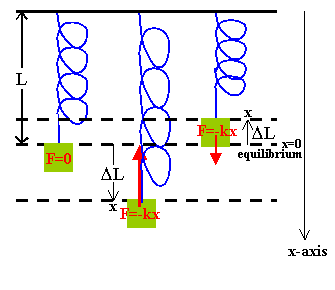In this lab you will explore the motion of a mass attached to a spring hanging vertically from a fixed support and the motion of a simple pendulum.
Open a Microsoft Word document to keep a log of your procedures and your results. This log will form the basis of lab report. Address the points highlighted in blue. Answer all questions.
Experiment
A spring has an equilibrium length L. When a spring is compressed, then a force with magnitude proportional to the decrease in its length from its equilibrium length is pushing each end away from the other. When a spring is stretched, then a force with magnitude proportional to the increase in its length from its equilibrium length is pulling each end towards the other.
If one end of a spring is fixed to a support and an object is attached to the other end, then the force exerted by the spring on the object has a magnitude proportional to the displacement ΔL of the free end from its equilibrium position. The direction of the force is always opposite to the direction of the displacement. If the x-axis of a coordinate system is chosen parallel to the spring and the equilibrium position of the free end of the spring is at x = 0, then the displacement ΔL is equal to x, and the force is F = -kx. The proportional constant k is called the spring constant. It is a measure of the spring's stiffness.

If an object attached to the free end of the spring is displaced along the x-axis (in the positive x-direction) and then released, the force exerted by the spring on the object will accelerate it towards the equilibrium position (in the negative x-direction). When it reaches the equilibrium position it will have its maximum speed. As it passes through the equilibrium position, the force the spring exerts on the object changes direction. The object now decelerates, until its speed is zero and it displacement is maximum in the negative x-direction. The acceleration is in the positive x-direction and the object again accelerates towards the equilibrium position. The object oscillates about the equilibrium position.
You will measure the period of the oscillations of different masses attached to the same spring. For a mass on a spring we expect
ω = √(k/m), T = 2π√(m/k).
To find the spring constant k you will plot T2 versus m. The slope of the best fitting straight line equals 4π2/k.
Procedure:
You will analyze 4 video clips, spring_x.mp4, x = 1 - 4. To play a video clip or to step through it frame-by-frame click the "Begin" button. The "Video Analysis" web page will open.
Analyze each of the clips to find the period of oscillation. Track
the point where the mass attaches to the spring. (See
Lab
9, hints.)
The weight of the object attached to the spring is given. Find its
mass. Construct a spreadsheet as shown below.
| Video Clip | mass m (kg) | period T(s) | T2 (s2) |
|---|---|---|---|
| 1 | |||
| 2 | |||
| 4 | |||
| 4 |
Paste your table and plot of T2 versus mass
and your value for the slope of the best fitting straight line into your log.
What value did you find for k and what is the uncertainty in k?
Exercise
In this exercise you will explore "The pendulum Lab" simulations.
Link to the simulation:
https://phet.colorado.edu/en/simulations/pendulum-lab
Click the "Lab" window.
The interface
Make the following measurements and answer the questions below
Let the length of the pendulum be 0.8 m and the mass be 0.5 kg. Choose no friction. The formula for the period of a pendulum derived in the notes is T = (2π) (L/g)1/2 for small oscillations.
Convert your log into a lab report.
Name:
E-mail address:
Laboratory 9 Report
Save your Word document (your name_lab9.docx), go to Canvas, Assignments, Lab 9, and submit your document.